![]()
Jean-Baptiste-Camille Corot, View of Lake Garda, ca. 1865–70
| Artist | Jean-Baptiste-Camille Corot, French, 1796–1875 |
| Title | View of Lake Garda |
| Object Date | ca. 1865–70 |
| Medium | Oil on canvas |
| Dimensions (Unframed) | 24 x 36 5/8 in. (61 x 93 cm) |
| Credit Line | The Nelson-Atkins Museum of Art. Gift of Clarke Bunting in memory of his wife, Catherine Conover Bunting, 80-44 |
Catalogue Entry
Citation
Chicago:
Simon Kelly, “Jean-Baptiste-Camille Corot, View of Lake Garda, ca. 1865–70,” catalogue entry in ed. Aimee Marcereau DeGalan French Paintings and Pastels, 1600–1945: The Collections of the Nelson-Atkins Museum of Art (Kansas City: The Nelson-Atkins Museum of Art, 2021), https://doi.org/10.37764/78973.5.504.5407.
MLA:
Kelly, Simon. “Jean-Baptiste-Camille Corot, View of Lake Garda, ca. 1865–70,” catalogue entry. French Paintings and Pastels, 1600–1945: The Collections of the Nelson-Atkins Museum of Art, edited by Aimee Marcereau DeGalan, The Nelson-Atkins Museum of Art, 2021. doi: 10.37764/78973.5.504.5407.
In this painting, Jean-Baptiste-Camille Corot presents an idyllic view on the banks of Lake Garda in Northern Italy. Two peasants—a boatman and a contadina, an Italian peasant woman—rest by the shore, a path winding back to their right. In the distance, a town sits on gently rolling hills. Corot renders his trees in elegant outlines, with his characteristic feathery foliage. Flecks of yellow and peach in the foreground suggest the presence of flowers. View of Lake Garda has the silvery tones characteristic of the artist’s late work, when he focused on the role of memory and produced imagery as though seen through a veil. Twenty-seven of his exhibited works at the Paris SalonSalon, the: Exhibitions organized by the French Royal Academy of Painting and Sculpture (Académie Royale de Peinture et de Sculpture) and its successor the Academy of Fine Arts (Académie des Beaux Arts), which took place in Paris from 1667 onward. and in French provincial exhibitions between 1855 and 1874 were termed “souvenirs” (or memories).1See Vincent Pomarède, “Le souvenir recomposé. Réflexions autour du thème du “souvenir” dans l’oeuvre de Corot,” in Chiara Stefani, Vincent Pomarède and Gérard de Wallens, ed, Corot, un artiste et son temps (1996; pub. Paris: Klincksieck, 1998), 444. Gary Tinterow has noted that this number represented “about one fifth of the works” publicly displayed by Corot during this period. Gary Tinterow, “Le Père Corot: The Very Poet of Landscape” in Gary Tinterow, Michael Pantazzi and Vincent Pomarède, Corot, 1796-1875, exh. cat. (New York: Metropolitan Museum of Art, 1996), 262. The writer Théophile Silvestre, who produced an early biography of Corot, remarked on the artist’s remarkable visual memory.2Corot told Théophile Silvestre, “When an amateur wants a ‘répétition’ of one of my landscapes, it is easy for me to give it to him without seeing the original; I keep a copy of all my works in my heart and in my eyes” (Lorsqu’un amateur désire la répétition d’un de mes paysages, il m’est facile de la lui donner sans revoir l’original; je garde dans le coeur et dans les yeux la copie de tous mes ouvrages). Quoted in Silvestre, Histoire des Artistes Vivants Français et Étrangers (Paris: E. Blanchard, 1856), 95.
Corot traveled extensively throughout his career, visiting Italy on three occasions: in 1825–1828, 1834, and 1843. View of Lake Garda relates to the 1834 trip, which included travels to Venice, Genoa, and the country’s northern lakes.3See Peter Galassi, Corot in Italy: Open-Air Painting and the Classical-Landscape Tradition (New Haven: Yale University Press, 1996). See also Michael Clarke, Chiara Stefani, and Vincent Pomarède, Corot: Natura, emozione, ricordo, exh. cat. (Ferrara: Ferrara arte, 2005). Corot spent sixteen days on Lake Garda, from September 10 to 26, at a time when the lake was emerging as a tourist destination. Indeed, a guidebook that explained its history and natural sites was published that very same year.4See Giacomo Mosconi, Ricordi d’un Viaggio Pittorico ai Laghi di Garda, di Loppio e di Ledro (Milan: Libreria di Francesco Sanvito, 1834). Corot stayed at Desenzano, on the southern tip of the lake, from September 10 to 16, before taking a steamer to the town of Riva, on the northern tip, where he stayed until the 22nd. He then returned to Desenzano, remaining there until the 26th. The artist documented his visit in a sketchbook, which includes panoramic views of Riva and Desenzano as well as figure studies of Italian peasant women and his fellow steamer travelers.5The carnet is housed in the Département des Arts Graphiques, Musée du Louvre, Paris, RF 8714 (see carnet sheets 37–44). See Giorgio Marini, “Schizzi en plein air e ‘ricordi’ grafici. Il ‘disegno de viaggio’ negli anni di Canella e Corot,” in Marina Botteri Ottaviani, Giorgio Marini, and Fernando Mazzocca, Corot e Canella: La nostalgia del lago, exh. cat. (Trento, Italy: Museo di Riva del Garda, 2008), 73–88. Particularly relevant to View of Lake Garda is a pencil study of Desenzano (Fig. 1), including distant vistas of the Cathedral of Saint Mary Magdalene and Tower of Saint Martin (Torre di San Martino).6Corot does slightly adapt, as he often did, the configuration of the architecture, but the overall view, with the hills descending to the lake edge, is very similar. Corot kept this sketchbook until the end of his life; it was one of around forty that appeared in his studio sale.
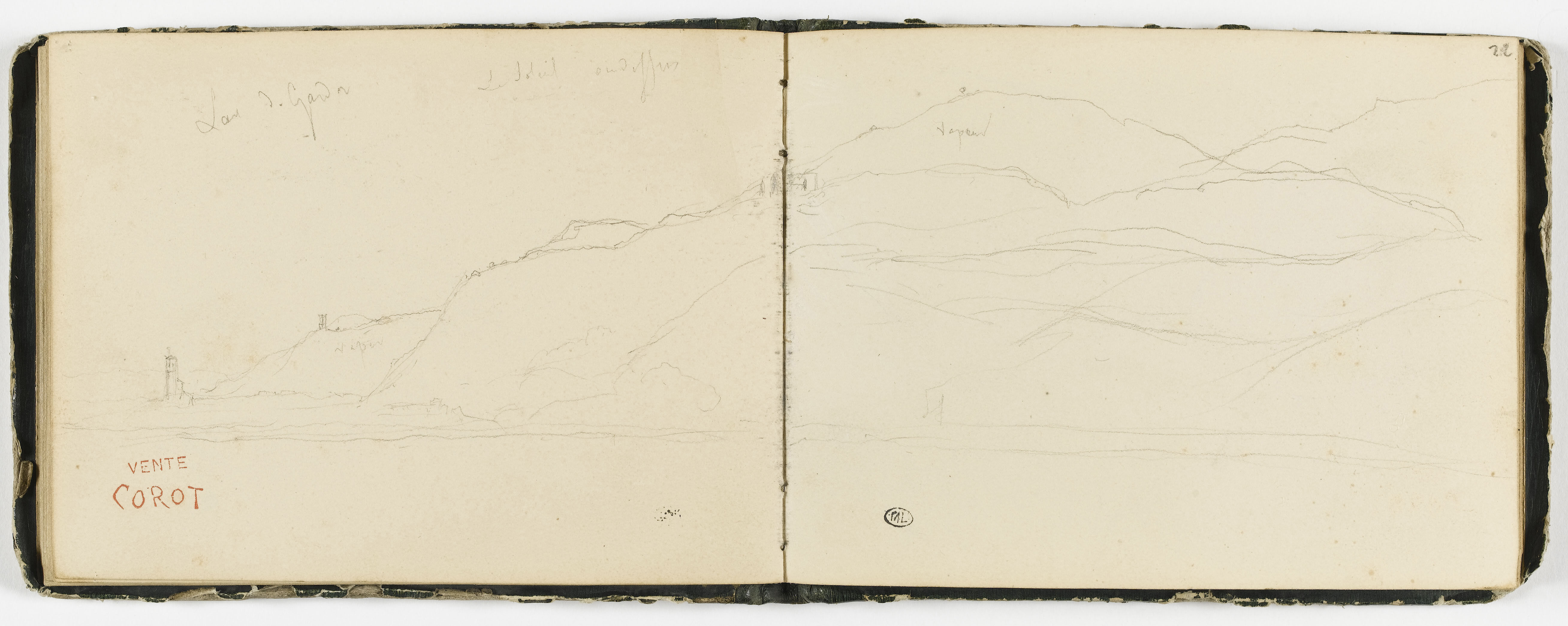
Particularly in his later work, Corot pursued a practice of paring down his compositions. Often he would paint out trees in order to create a more spare and less crowded pictorial arrangement. Technical analysis has shown this, for example, in Shepherd Star (1864; Musée des Augustins, Toulouse), while photographs of other paintings in progress also reveal the same approach.8See Simon Kelly, “Strategies of Repetition: Millet/Corot” in Eik Kahng, ed., The Repeating Image: Multiples in French Painting from David to Matisse (Baltimore: Walters Art Museum and Yale University Press, 2007), 60–64. The practice is evident, too, in View of Lake Garda. X-radiography has shown that Corot originally included an overarching tree to the left of his composition and that the horizon line was also higher (see technical entry, Fig. 3).9See technical notes by Mary Schafer, NAMA paintings conservator, July 16, 2008, NAMA conservation file. As he re-worked his composition, the artist painted over these elements. Corot, indeed, noted in a carnet (or notebook) that he was “never focused on creating detail” since “the masses and the character of the painting interest me above all.”10See carnet no. 68, p. 30: “jamais pressé d’arriver au détail…les masses et le caractère du tableau m’intéressent avant tout.”
The majority of Corot’s many views of Lake Garda, made from 1834 until his death, focus on the area around Riva. These have attracted significant attention in the Corot literature as a case study of the artist’s stylistic evolution over the course of his career: his move away from direct naturalism to works of poetic memory.11They were extensively documented in the 1996 Corot exhibition (see Tinterow et al., Corot) and also explored in Vincent Pomarède, Corot: Naturaleza, emoción, recuerdo, exh. cat. (Madrid: Museo Thyssen-Bornemisza, 2005). A plein-airen plein air (adjective: plein-air): French for “outdoors.” The term is used to describe the act of painting quickly outside rather than in a studio. study of Riva in 1834 served as the basis for a larger studio painting, Vue prise à Riva (Kunstmuseum, St. Gallen, Switzerland), that was shown at the 1835 Salon. Corot then showed another Riva view at the 1850 Salon (Musée des Beaux-Arts, Marseille). Subsequently, in the 1860s and 1870s, he produced two later souvenir works: Souvenir of Riva: Evening Glow (about 1865–1870; Taft Museum of Art, Cincinnati) and Souvenir of Riva (1874; private collection). View of Lake Garda is unusual in that it relates to the Desenzano area of the lake, although it is not unprecedented in Corot’s oeuvre; he also produced a plein-air oil sketch of Desenzano in 1834 (Fig. 2).
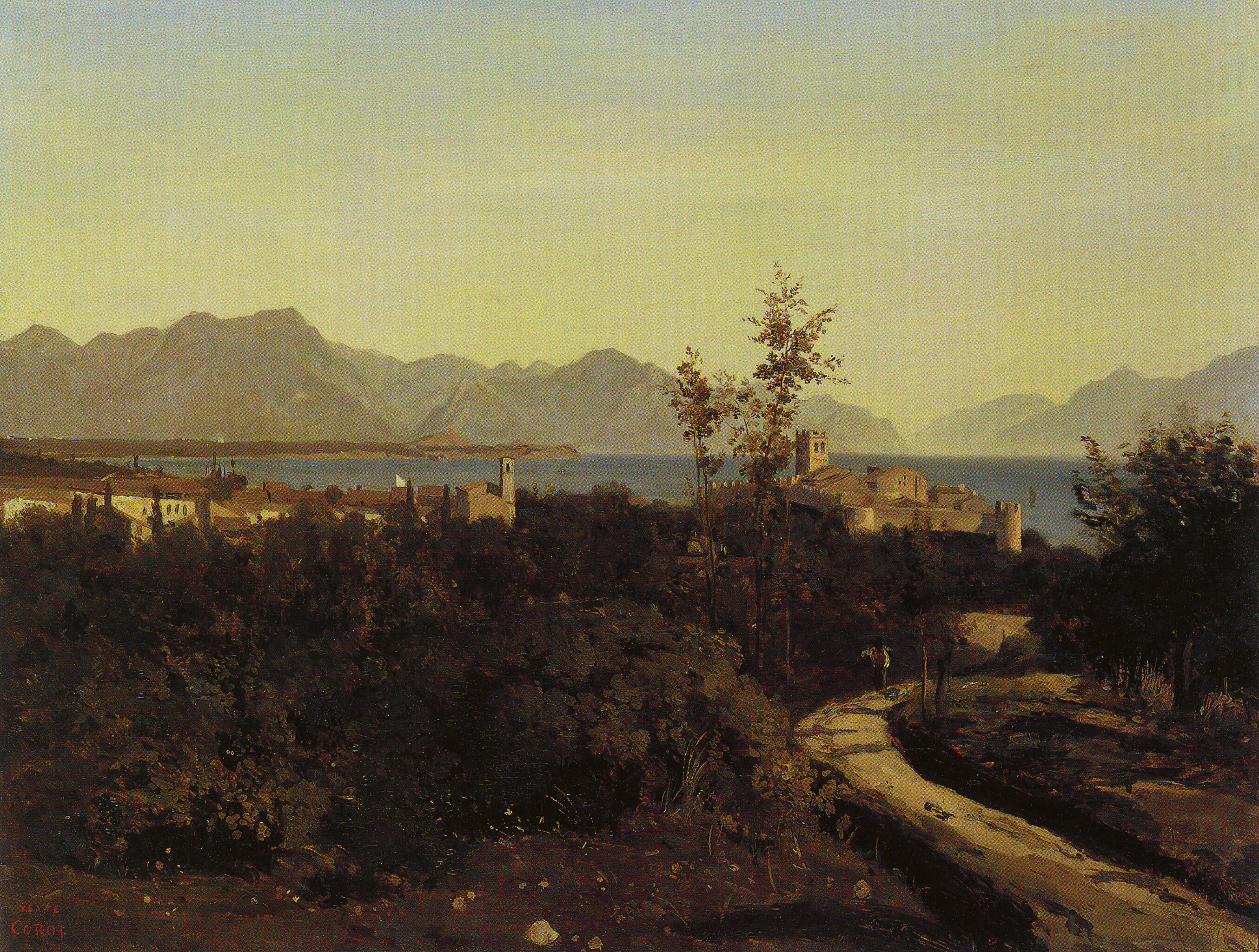
O lake! Silent rocks! Caves! Dark forest!
You, whom Time spares or can make young again,
Keep of that night, keep, beautiful nature,
At least the memory!13“Ô lac! rochers muets! grottes! forêt obscure! / Vous, que le temps épargne ou qu’il peut rajeunir, / Gardez de cette nuit, gardez, belle nature, / Au moins le souvenir!” “Méditation Dixième: Le Lac de B***,” in Méditations poétiques (Paris: Dépot de la Librairie Grecque-Latine-Allemande, 1820), 48. English translation by David Paley, www.poemswithoutfrontiers.com/Le_Lac.
The evocative association of love and memory with the motif of the lake in Lamartine’s poetry suggests a romantic association between the peasant man and woman in the Nelson-Atkins painting.
View of Lake Garda was sold to an M. Basset around 1870 for 800 francs, a relatively small amount for Corot’s work, as his prices increased in his final years.14In 1866, for example, he sold his Solitude. Recollection of Vigen, Limousin (1866; Carmen Thyssen-Bornemisza Collection on loan at the Museo Nacional Thyssen-Bornemisza, Madrid. Inv. no. [CTB.1999.27]) to the Empress Eugenia de Montijo for her private collection for 18,000 francs It was subsequently acquired by the Belgian collector, painter, and member of the Barbizon community, the Chevalier de Knyff. In recent years, the work has attracted relatively little interest in Corot literature and has seldom been shown in exhibitions.15It was last lent for exhibition in 1997; see Gabriel P. Weisberg, Collecting in the Gilded Age: Art Patronage in Pittsburgh, 1890–1910, exh. cat. (Pittsburgh: Frick Art and Historical Center, 1997), 157–58, 173, 181, 196, 372n132, 405 (repro.), as Le Lac de Garde (View of Lake Garda). It was, however, one of Corot’s better-known works in the late nineteenth century, appearing in his posthumous retrospective at the 1878 Exposition Universelle and in Georges Petit’s prestigious show of one hundred masterpieces from Parisian private collections in 1883. It also appeared in Corot’s impressive display of more than forty paintings—the largest of any Barbizon painter—at the 1889 Exposition Universelle. Subsequently it was acquired by the prominent American collector and founder of the National Gallery of Art, Andrew W. Mellon. Around 1912, the picture was displayed in the living room of Mellon’s house on Forbes Street, New York. As Paul Mellon, Andrew’s son, later remembered, it hung together with another Corot landscape and a landscape full of cows by the Dutch artist Aelbert Cuyp (1620–1691).16See Paul Mellon, Reflections in a Silver Spoon: A Memoir (New York: William Morrow, 1992), 67. The picture was inherited by Paul Mellon and later given to his sister-in-law, Catherine Conover Bunting. Her husband gave it the Nelson-Atkins Museum of Art in her memory.
Notes
-
See Vincent Pomarède, “Le souvenir recomposé. Réflexions autour du thème du “souvenir” dans l’oeuvre de Corot,” in Chiara Stefani, Vincent Pomarède and Gérard de Wallens, ed, Corot, un artiste et son temps (1996; pub. Paris: Klincksieck, 1998), 444. Gary Tinterow has noted that this number represented “about one fifth of the works” publicly displayed by Corot during this period. Gary Tinterow, “Le Père Corot: The Very Poet of Landscape” in Gary Tinterow, Michael Pantazzi and Vincent Pomarède, Corot, 1796-1875, exh. cat. (New York: Metropolitan Museum of Art, 1996), 262.
-
Corot told Théophile Silvestre, “When an amateur wants a ‘répétition’ of one of my landscapes, it is easy for me to give it to him without seeing the original; I keep a copy of all my works in my heart and in my eyes” (Lorsqu’un amateur désire la répétition d’un de mes paysages, il m’est facile de la lui donner sans revoir l’original; je garde dans le coeur et dans les yeux la copie de tous mes ouvrages). Quoted in Silvestre, Histoire des Artistes Vivants Français et Étrangers (Paris: E. Blanchard, 1856), 95.
-
See Peter Galassi, Corot in Italy: Open-Air Painting and the Classical-Landscape Tradition (New Haven: Yale University Press, 1996). See also Michael Clarke, Chiara Stefani, and Vincent Pomarède, Corot: Natura, emozione, ricordo, exh. cat. (Ferrara: Ferrara arte, 2005).
-
See Giacomo Mosconi, Ricordi d’un Viaggio Pittorico ai Laghi di Garda, di Loppio e di Ledro (Milan: Libreria di Francesco Sanvito, 1834).
-
The carnet is housed in the Département des Arts Graphiques, Musée du Louvre, Paris, RF 8714 (see carnet sheets 37–44). See Giorgio Marini, “Schizzi en plein air e ‘ricordi’ grafici. Il ‘disegno de viaggio’ negli anni di Canella e Corot,” in Marina Botteri Ottaviani, Giorgio Marini, and Fernando Mazzocca, Corot e Canella: La nostalgia del lago, exh. cat. (Trento, Italy: Museo di Riva del Garda, 2008), 73–88.
-
Corot does slightly adapt, as he often did, the configuration of the architecture, but the overall view, with the hills descending to the lake edge, is very similar.
-
See Fronia E. Wissmann, “Arbres torturés, ailes de fées: Les sources des peintures de Salon de Corot,” in Chiara Stefani, Corot, un artiste et son temps (1996; pub. Paris: Klincksieck, 1998), 248–78.
-
See Simon Kelly, “Strategies of Repetition: Millet/Corot” in Eik Kahng, ed., The Repeating Image: Multiples in French Painting from David to Matisse (Baltimore: Walters Art Museum and Yale University Press, 2007), 60–64.
-
See technical notes by Mary Schafer, NAMA paintings conservator, July 16, 2008, NAMA conservation file.
-
See carnet no. 68, p. 30: “jamais pressé d’arriver au détail…les masses et le caractère du tableau m’intéressent avant tout.”
-
They were extensively documented in the 1996 Corot exhibition (see Tinterow et al., Corot) and also explored in Vincent Pomarède, Corot: Naturaleza, emoción, recuerdo, exh. cat. (Madrid: Museo Thyssen-Bornemisza, 2005).
-
Pomarède, Corot, 2005.
-
“Ô lac! rochers muets! grottes! forêt obscure! / Vous, que le temps épargne ou qu’il peut rajeunir, / Gardez de cette nuit, gardez, belle nature, / Au moins le souvenir!” “Méditation Dixième: Le Lac de B***,” in Méditations poétiques (Paris: Dépot de la Librairie Grecque-Latine-Allemande, 1820), 48. English translation by David Paley, www.poemswithoutfrontiers.com/Le_Lac.
-
In 1866, for example, he sold his Solitude. Recollection of Vigen, Limousin (1866; Carmen Thyssen-Bornemisza Collection on loan at the Museo Nacional Thyssen-Bornemisza, Madrid. Inv. no. [CTB.1999.27]) to the Empress Eugenia de Montijo for her private collection for 18,000 francs.
-
It was last lent for exhibition in 1997; see Gabriel P. Weisberg, Collecting in the Gilded Age: Art Patronage in Pittsburgh, 1890–1910, exh. cat. (Pittsburgh: Frick Art and Historical Center, 1997), 157–58, 173, 181, 196, 372n132, 405 (repro.), as Le Lac de Garde (View of Lake Garda).
-
See Paul Mellon, Reflections in a Silver Spoon: A Memoir (New York: William Morrow, 1992), 67.
Technical Entry
Citation
Chicago:
Mary Schafer, “Jean-Baptiste-Camille Corot, View of Lake Garda, ca. 1865–70,” technical entry in ed. Aimee Marcereau DeGalan French Paintings and Pastels, 1600–1945: The Collections of the Nelson-Atkins Museum of Art (Kansas City: The Nelson-Atkins Museum of Art, 2021), https://doi.org/10.37764/78973.5.504.2088.
MLA:
Schafer, Mary. “Jean-Baptiste-Camille Corot, View of Lake Garda, ca. 1865–70,” technical entry. French Paintings and Pastels, 1600–1945: The Collections of the Nelson-Atkins Museum of Art, edited by Aimee Marcereau DeGalan, The Nelson-Atkins Museum of Art, 2021. doi: 10.37764/78973.5.504.2088.
Jean-Baptist-Camille Corot (1796–1875) simplified the initial composition of View of Lake Garda with four substantial changes.1Technical studies have uncovered compositional reworking on numerous works by the artist. See Sarah Herring, “Six Paintings by Corot: Methods, Materials, and Sources,” National Gallery Technical Bulletin (2009): 86–112; see also Madeleine Hours, “Figures de Corot,” Bulletin du Laboratoire du Musée du Louvre 7 (1962): 3–39. The x-radiographX-ray radiography (also referred to as x-radiography or radiography): Radiography is an examination tool analogous to the use of X-rays in medicine whereby denser components of a painted composition can be recorded as an inverted shadow image cast on film or a digital X-ray imaging plate from a source such as an X-ray tube. The method has been used for more than a century and is most effective with dense pigments incorporating metallic elements such as lead or zinc. It can reveal artist changes, underlying compositions, and information concerning the artwork’s construction and condition. The resulting image is called an x-radiograph or radiograph. It differs from the uses of X-ray spectrometry in being dependent on the density of the paint to absorb X-rays before they reach the film or image plate and being non-specific as to which elements are responsible for the resulting shadow image. reveals a large, multi-branched tree that was once a strong diagonal feature within the landscape, located to the left of the figures and extending toward the upper left corner (Fig. 3).2See x-radiograph film, no. 283, NAMA conservation file, 80-44. The x-radiographs were captured in 1994 under the following conditions: 50 kV, 7 mAs, and 20 seconds. The branches of a large coniferous tree in the upper center were modified with additions of gray and peach paint, and above this section of reinstated sky, Corot added a slender tree with delicate branches. A second mountain range, now covered by overlying paint, is also evident in the x-radiograph. Infrared reflectographyinfrared reflectography (IRR): A form of infrared imaging that exploits the behavior of painting materials at wavelengths beyond those accessible to infrared photography. These advantages sometimes include a continuing increase in the transparency of pigments beyond wavelengths accessible to infrared photography (i.e, beyond 1,000 nanometers), rendering underdrawing more clearly. The resulting image is called an infrared reflectogram. Devices that came into common use in the 1980s such as the infrared vidicon effectively revealed these features but suffered from lack of sharpness and uneven response. Vidicons continue to be used out to 2,200 nanometers but several newer pixelated detectors including indium gallium arsenide and indium antimonide array detectors offer improvements. All of these devices are optimally used with filters constraining their response to those parts of the infrared spectrum that reveal the most within the constraints of the palette used for a given painting. They can be used for transmitted light imaging as well as in reflection. reveals a narrow tree at the lower left corner and a dark rectangular shape near the central mountains (Fig. 4).3The rectangular shape, second mountain range, and tree branches on the upper left corner are more easily viewed with the longer wavelength range of the Hamamatsu vidicon camera. The rectangular shape is also evident as a radio-transparent area in the x-radiograph (Fig. 3).
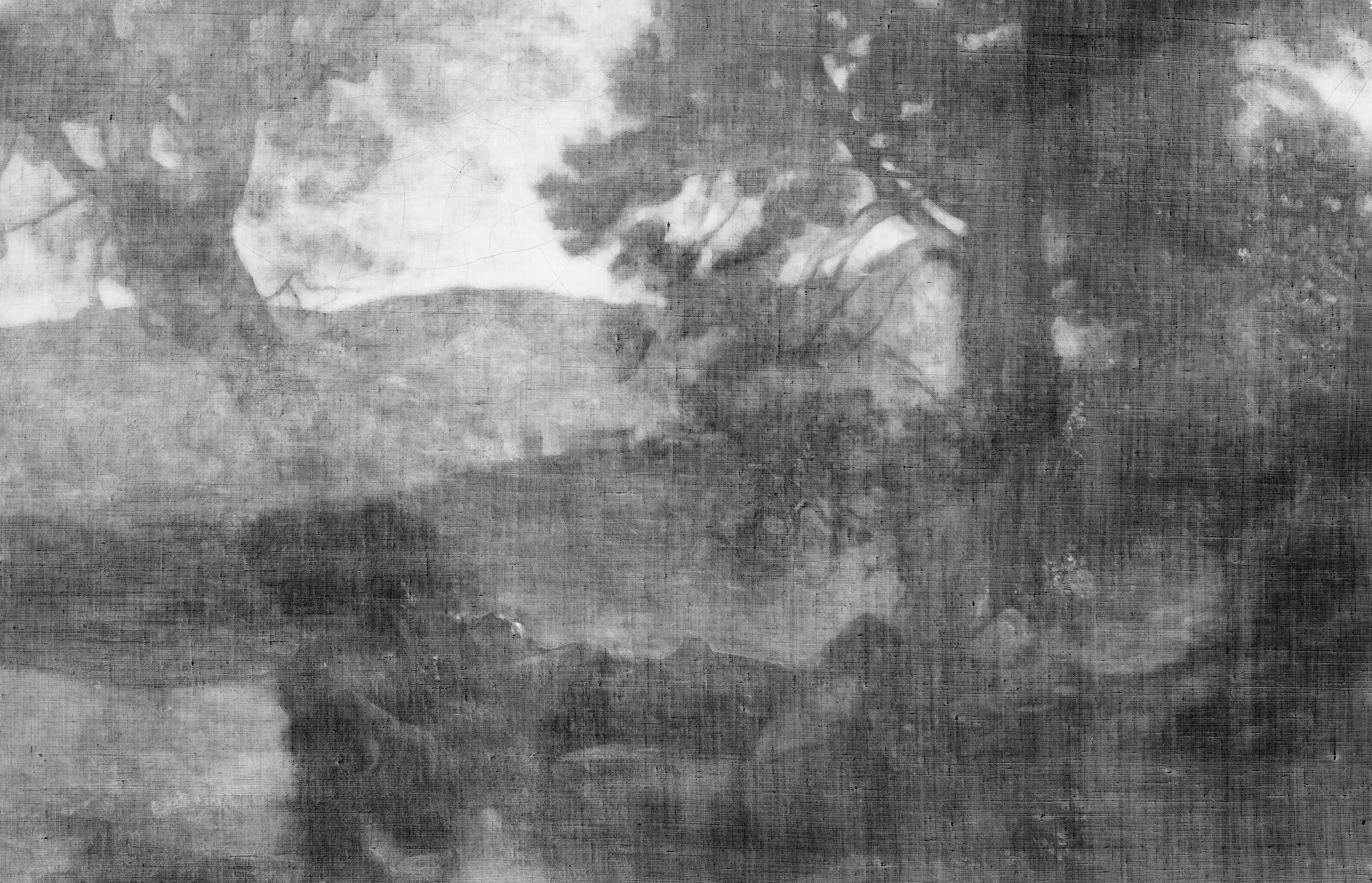 Fig. 3. X-radiograph, View of Lake Garda (ca. 1865–70)
Fig. 3. X-radiograph, View of Lake Garda (ca. 1865–70)
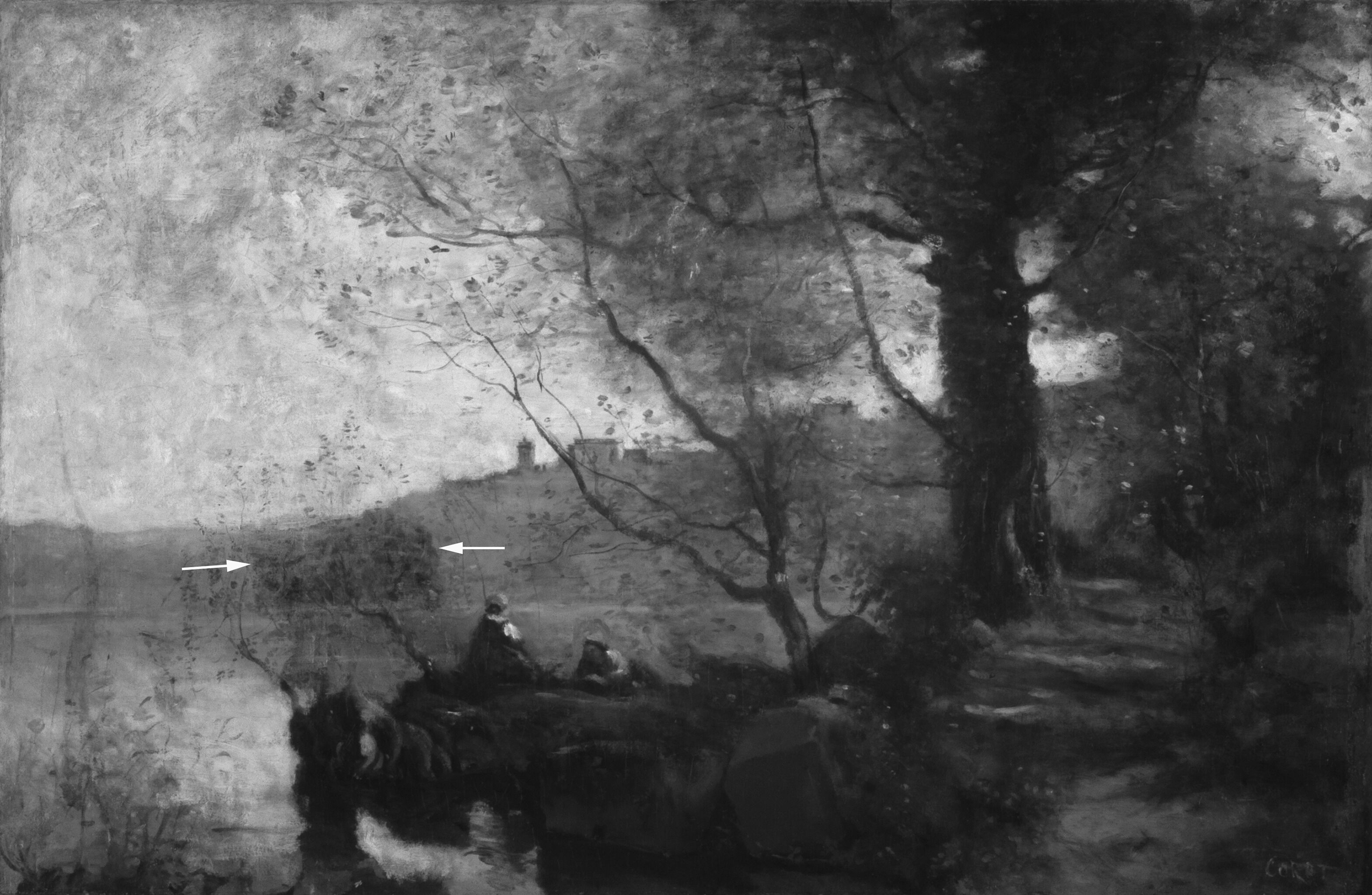 Fig. 4. Reflected infrared digital photograph of View of Lake Garda (ca. 1865–70)
Fig. 4. Reflected infrared digital photograph of View of Lake Garda (ca. 1865–70)
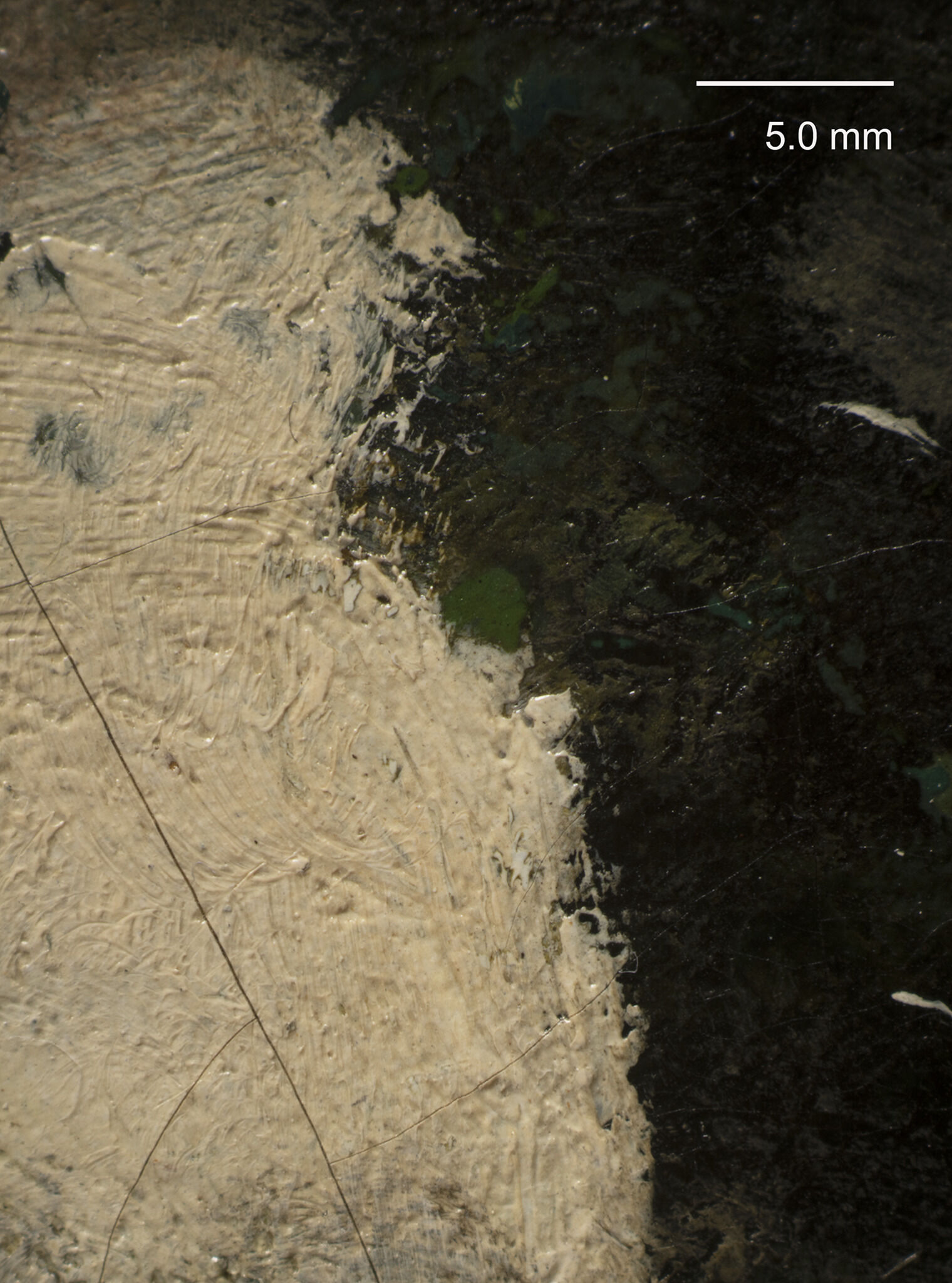 Fig. 5. Photomicrograph of View of Lake Garda (ca. 1865–70) showing the peach paint of the sky on top of the right tree
Fig. 5. Photomicrograph of View of Lake Garda (ca. 1865–70) showing the peach paint of the sky on top of the right tree
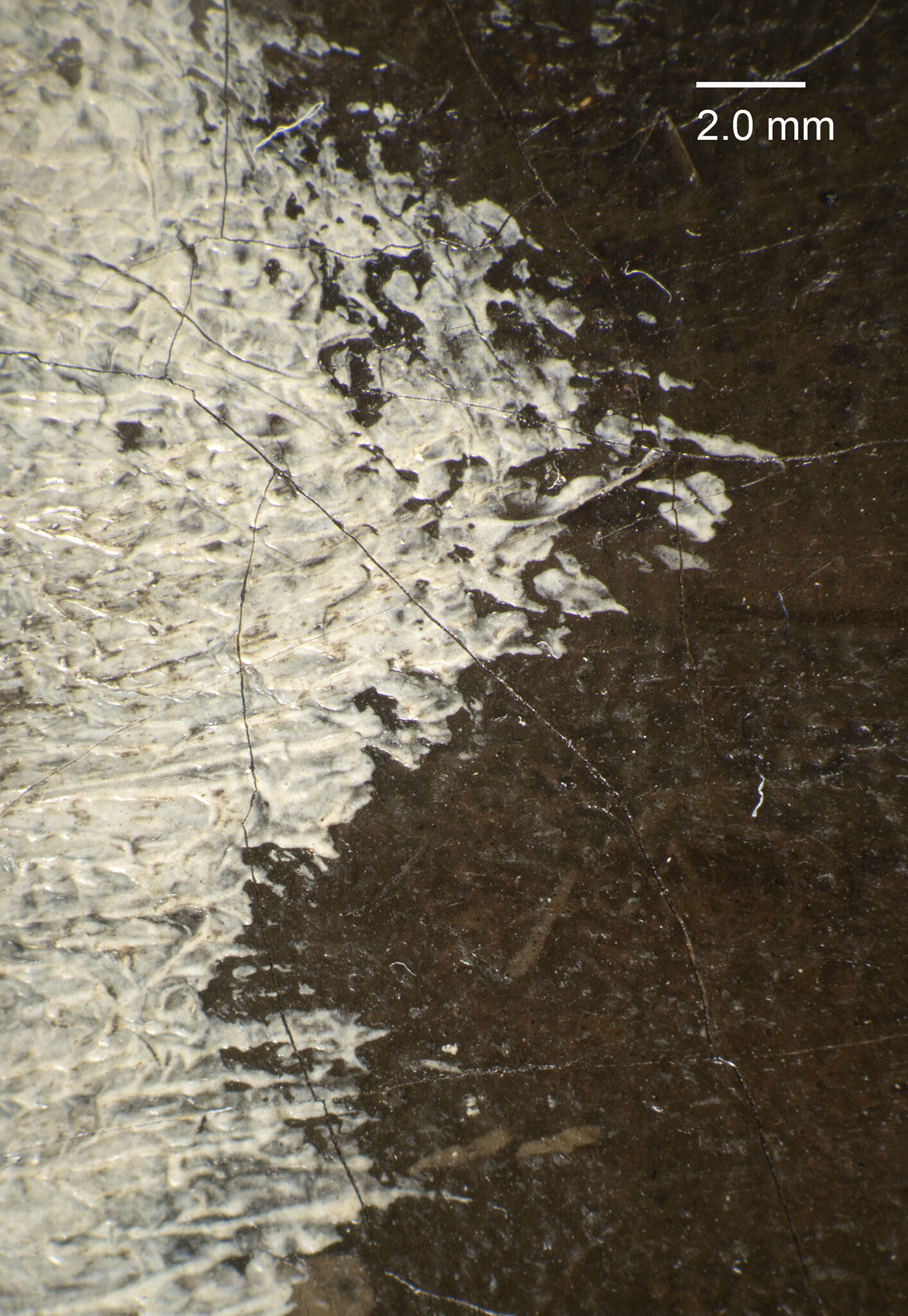 Fig. 6. Photomicrograph of View of Lake Garda (ca. 1865–70) showing the pale blue paint of the water covering the brown reflection of the tree
Fig. 6. Photomicrograph of View of Lake Garda (ca. 1865–70) showing the pale blue paint of the water covering the brown reflection of the tree
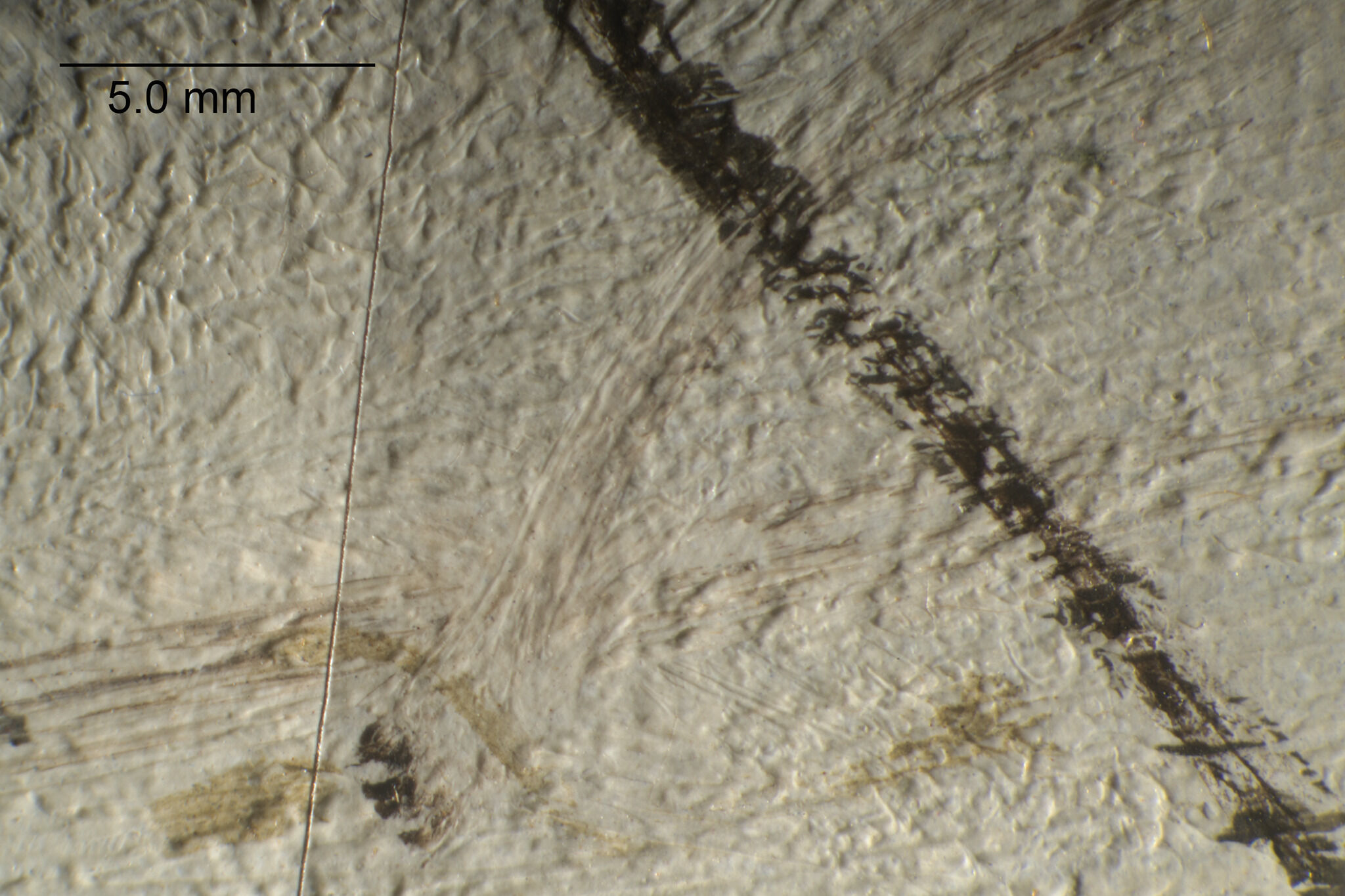 Fig. 7. Photomicrograph of View of Lake Garda (ca. 1865–70) showing wet-over-wet and wet-over-dry brushwork in the tree branches
Fig. 7. Photomicrograph of View of Lake Garda (ca. 1865–70) showing wet-over-wet and wet-over-dry brushwork in the tree branches
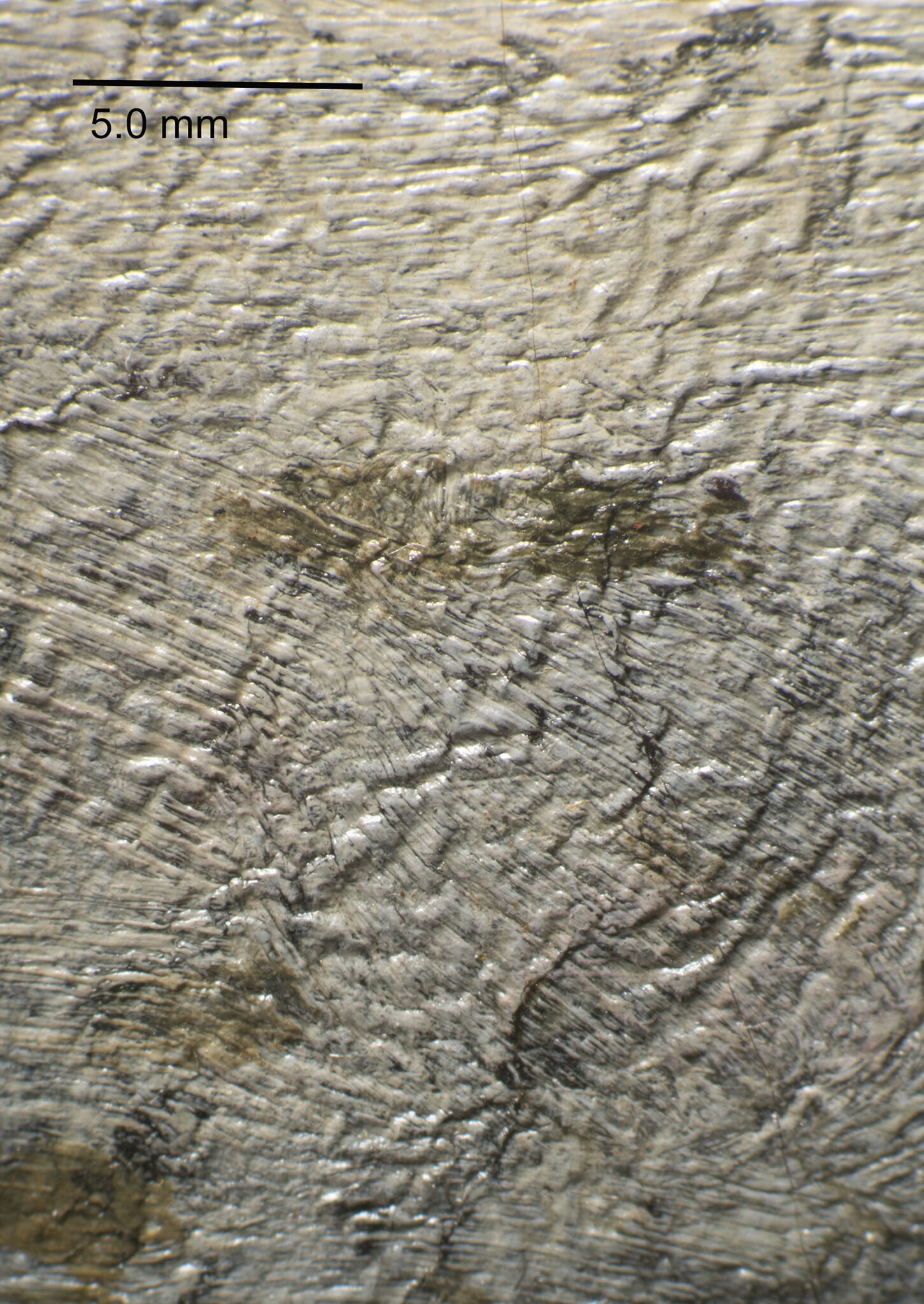 Fig. 8. Photomicrograph of View of Lake Garda (ca. 1865–70) showing paint wrinkling
Fig. 8. Photomicrograph of View of Lake Garda (ca. 1865–70) showing paint wrinkling
View of Lake Garda was painted on a lightweight, plain weaveplain weave: A basic textile weave in which one weft thread alternates over and under the warp threads. Often this structure consists of one thread in each direction, but threads can be doubled (basket weave) or tripled to create more complex plain weave. Plain weave is sometimes called tabby weave. canvas that was commercially-primed. Two fragments of the original tacking margintacking margins: The outer edges of canvas that wrap around and are attached to the stretcher or strainer with tacks or staples. See also tacking edge. are encapsulated on the painting reverse and confirm that the ground layer was present on at least a portion of these edges. The dimensions of the painting do not correspond to a standard stretcherstandard-format supports: Commercially prepared supports available through art suppliers, which gained popularity in the nineteenth century during the industrialization of art materials. Available in three formats figure (portrait), paysage (landscape), and marine (marine), these were numbered 1 through 120 to indicate their size. For each numbered size, marine and paysage had two options available: a larger format (haute) and smaller (basse) format. size.8Jacques-Nicolas Paillot de Montabert, Traité complet de la peinture, vol. 9 (Paris: Bossange Père, 1829), 147.
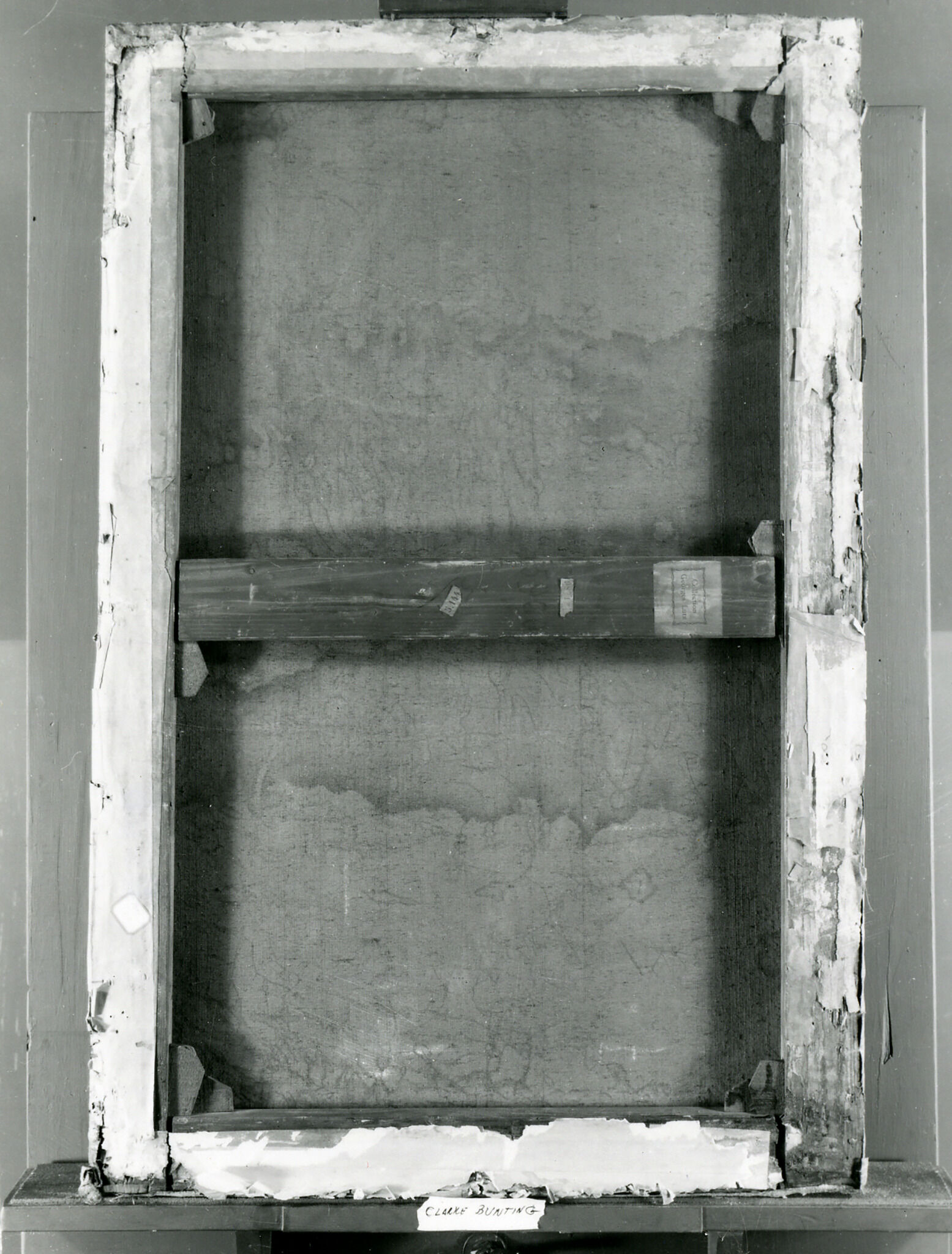
Notes
-
Technical studies have uncovered compositional reworking on numerous works by the artist. See Sarah Herring, “Six Paintings by Corot: Methods, Materials, and Sources,” National Gallery Technical Bulletin (2009): 86–112; see also Madeleine Hours, “Figures de Corot,” Bulletin du Laboratoire du Musée du Louvre 7 (1962): 3–39.
-
See x-radiograph film, no. 283, NAMA conservation file, 80-44. The x-radiographs were captured in 1994 under the following conditions: 50 kV, 7 mAs, and 20 seconds.
-
The rectangular shape, second mountain range, and tree branches on the upper left corner are more easily viewed with the longer wavelength range of the Hamamatsu vidicon camera. The rectangular shape is also evident as a radio-transparent area in the x-radiograph (Fig. 3).
-
See Herring, “Six Paintings by Corot,” 87. Herring notes that Corot’s practice, whether he was painting outdoors or in his studio, was to paint the trees first and the sky last. She quotes Corot from Carnet 17, ca. 1855–1860, R 3054: “a good method to follow: on your white canvas, begin with the strongest tone. Follow in order as far as the lightest tone. It is not logical to begin with the sky.”
-
Herring, “Six Paintings by Corot,” 87. Small quantities of natural resin were identified in a number of Corot paintings at the National Gallery of Art, London. “The resin would have been incorporated into the paint in the form of varnish, which Corot presumably added on his palette as he worked… The addition of a little varnish would have improved the working properties and increased the transparency and gloss of the paint, giving greater saturation of color.”
-
Renate Woudhuysen-Keller, “Observations Concerning Corot’s Late Painting Technique” in A. Burmester, C.H. Heilmann, and M. F. Zimmermann, Barbizon. Malerei der Natur – Natur der Malerei (papers given at a 1996 symposium in conjunction with the exhibition Corot, Courbet und die Maler von Barbizon: “Les amis de la nature” Haus der Kunst, Munich), 1999, 194. See photomicrograph of Les Evaux in Plate 39 on page 240.
-
See x-radiograph and detail image of Woman with a Pearl in Madeleine Hours, Jean-Baptiste-Camille Corot (New York: Abrams, 1984), 36–38.
-
Jacques-Nicolas Paillot de Montabert, Traité complet de la peinture, vol. 9 (Paris: Bossange Père, 1829), 147.
-
James Roth, July 7, 1971, treatment report, NAMA conservation file, no. 80-44.
Documentation
Citation
Chicago:
Glynnis Napier Stevenson, “Jean-Baptiste-Camille Corot, View of Lake Garda, ca. 1865–70,” documentation in ed. Aimee Marcereau DeGalan French Paintings and Pastels, 1600–1945: The Collections of the Nelson-Atkins Museum of Art (Kansas City: The Nelson-Atkins Museum of Art, 2021), https://doi.org/10.37764/78973.5.504.4033.
MLA:
Stevenson, Glynnis Napier. “Jean-Baptiste-Camille Corot, View of Lake Garda, ca. 1865–70,” documentation. French Paintings and Pastels, 1600–1945: The Collections of the Nelson-Atkins Museum of Art, edited by Aimee Marcereau DeGalan, The Nelson-Atkins Museum of Art, 2021. doi: 10.37764/78973.5.504.4033
Provenance
Citation
Chicago:
Glynnis Napier Stevenson, “Jean-Baptiste-Camille Corot, View of Lake Garda, ca. 1865–70,” documentation in ed. Aimee Marcereau DeGalan French Paintings and Pastels, 1600–1945: The Collections of the Nelson-Atkins Museum of Art (Kansas City: The Nelson-Atkins Museum of Art, 2021), https://doi.org/10.37764/78973.5.504.4033.
MLA:
Stevenson, Glynnis Napier. “Jean-Baptiste-Camille Corot, View of Lake Garda, ca. 1865–70,” documentation. French Paintings and Pastels, 1600–1945: The Collections of the Nelson-Atkins Museum of Art, edited by Aimee Marcereau DeGalan, The Nelson-Atkins Museum of Art, 2021. doi: 10.37764/78973.5.504.4033.
Purchased from the artist by M. Basset, ca. 1870 [1];
Jules-Frédéric Perreau (1821–81), Paris;
Hector Defoër-Bey (1832–1905), Paris;
Chevalier Alfred de Knyff (1819–85), Brussels and Paris, by May 1, 1878;
Albert Wolff (1835–91), Paris, by June 1883;
Purchased from Albert Wolff by Georges Lutz (1835–1901), Paris, by November 19, 1885–1901 [2];
Purchased at his posthumous sale, Collection Georges Lutz, importants tableaux modernes, aquarelles, pastels, dessins par Boilly, Bonvin, Boudin, Corot, Courbet, Daubigny, Daumier, Decamps, Delacroix, Diaz, Jules Dupré, Fantin Latour, Français, Fromentin, Géricault, Gervex, Harpignies, Henner, Isabey, Charles Jacque, Jongkind, Jules Lefebvre, Lépine, Meissonier, J.F. Millet, Ribot, Ricard, Th. Rousseau, Servin, Tassaert, Troyon, Vollon, Ziem, etc.: oeuvre capitale de Corot: Le Lac de Garde; remarquable collection de bronzes par Barye, Galerie Georges Petit, Paris, May 26, 1902, lot 31, as Le Lac de Garde, by Georges Bottolier-Lasquin for Arnold and Tripp, Paris, May 26, 1902–July 7, 1902;
Purchased from Arnold and Tripp, Paris, by Knoedler and Co., New York, Stock Book 5, No. 9871, July 7, 1902–September 8, 1902 [3];
Purchased from Knoedler and Co., New York, by Andrew W. Mellon (1855–1937), New York, September 8, 1902–37;
To his son, Paul Mellon (1907–99), Upperville, VA, ca. August 26, 1937–after September 10, 1941 [4];
Given by Paul Mellon to his wife’s parents, Dr. Charles Clinton (1871–1962) and Perla Mae (née Petty, 1879–1970) Conover, Kansas City, MO, after September 10, 1941–ca. May 18, 1971 [5];
To their daughter, Catherine Bunting (née Conover, 1913–80), Kansas City, MO, by May 18, 1971–80 [6];
To her husband, Clarke S. P. Bunting (1912–2001), Kansas City, MO, by November 1980–December 19, 1980;
Given by Clarke S. P. Bunting in memory of his wife, Catherine Conover Bunting, to The Nelson-Atkins Museum of Art, Kansas City, MO, 1980.
Notes
[1] M. Basset appears to be an art dealer, though more specifics were not found. See Inventaire général des richesses d’art de la France: Province, vol. 1 (Paris: E. Plon et Cie, 1878), 20.
[2] See Georges Loiseau, “M. Georges Lutz,” Le Magasin pittoresque 2 (January 1, 1901). Georges Lutz saw Albert Wolff’s collection at the 1883 Georges Petit exhibition. In 1885, he went to Wolff’s home and purchased several of Wolff’s paintings.
[3] Knoedler purchased the picture in half-share from Arnold and Tripp on July 7, 1902. See Knoedler and Company, New York, Stock Book 5, No. 9871, Getty Research Institute, Los Angeles. On the same day, Knoedler purchased Corot’s painting Le Matin (Knoedler No. 9872) in half-share. When Knoedler sold Le lac de garde to Andrew Mellon on September 8, 1902, they sold their half-share of Le Matin back to Arnold and Tripp for double the original price at the same time. There is no notation stating that Knoedler sold their half-share in Le lac de garde back to Arnold and Tripp, but the exchange of Le Matin seems to have been part of those negotiations.
[4] See letter dated May 9, 1937 from Paul Mellon to Andrew Mellon cited in David Cannadine, Mellon: An American Life (New York: Alfred A. Knopf, 2006), 574, in which Paul tells his father “I don’t want to buy them [two Corot’s].” From this, we can surmise that Paul did not have the paintings until sometime around his father’s death in August 1937. An entry in the 1937 inventory of Andrew Mellon’s estate reads: “J.B.C. Corot, Le lac de garde/or, Landscape with castle in background”, noted as “purchased Sept. 8, 1902, M. Knoedler & Co., Inc.” and also noted as “being distributed to Paul Mellon” from Andrew Mellon’s estate. See correspondence from Beverly Carter, Estate of Paul Mellon, to Glynnis Napier Stevenson, NAMA, August 22, 2019, NAMA curatorial files.
[5] See correspondence from Beverly Carter, Estate of Paul Mellon, to Glynnis Napier Stevenson, NAMA, August 22, 2019, NAMA curatorial files. Mellon’s secretary noted that Mellon had sent the Corot to his wife’s family in Kansas City on loan on September 10, 1941. There is no note of it ever returning to Paul Mellon. Ms. Carter, the executor of Paul Mellon’s estate, believes he would not have asked the Conovers to return it after their daughter’s, Mary Mellon, passing in 1946.
[6] Relining fragments with a label on the back dated May 18, 1971 indicate that conservator James Roth relined this painting when the Buntings owned it.
Related Works
Citation
Chicago:
Glynnis Napier Stevenson, “Jean-Baptiste-Camille Corot, View of Lake Garda, ca. 1865–70,” documentation in ed. Aimee Marcereau DeGalan French Paintings and Pastels, 1600–1945: The Collections of the Nelson-Atkins Museum of Art (Kansas City: The Nelson-Atkins Museum of Art, 2021), https://doi.org/10.37764/78973.5.504.4033.
MLA:
Stevenson, Glynnis Napier. “Jean-Baptiste-Camille Corot, View of Lake Garda, ca. 1865–70,” documentation. French Paintings and Pastels, 1600–1945: The Collections of the Nelson-Atkins Museum of Art, edited by Aimee Marcereau DeGalan, The Nelson-Atkins Museum of Art, 2021. doi: 10.37764/78973.5.504.4033.
Jean-Baptiste-Camille Corot, View of Desenzano on Lake Garda, 1834, oil on paper glued on canvas, 13 2/5 x 17 1/2 in. (34 x 44.5 cm), Private Collection, Switzerland.
Jean-Baptiste-Camille Corot, View near Riva on Lake Garda, 1834, oil on paper glued on canvas, 11 2/5 x 16 7/50 in. (29 x 41 cm), Sturzeneggersche Gemäldesammlung, Kunstmuseum, St. Gallen, Switzerland.
Jean-Baptiste-Camille Corot, Landscape near Riva on Lake Garda, 1835, oil on canvas, 38 4/5 x 55 7/10 in. (98.6 x 141.5 cm), Neue Pinakothek, Munich.
Jean-Baptiste-Camille Corot, Lake Garda, ca. 1847, oil on canvas, 12 4/5 x 9 3/5 in. (32.5 x 24.5 cm), location unknown, cited in Catalogue des tableaux modernes: aquarelles, pastels, dessins appartenant a M. Georges Feydeau (Paris: Hôtel Drouot, April 3, 1903).
Jean-Baptiste-Camille Corot, View of Riva, Italian Tyrol, ca. 1850, oil on canvas, 28 7/10 x 48 2/5 in. (73 x 123 cm), Musée des Beaux-Arts, Marseille.
Jean-Baptiste-Camille Corot, The Boatman of Mortefontaine, ca. 1865–72, oil on canvas, 24 x 35 3/8 in. (61 x 89.9 cm), The Frick Collection, New York.
Jean-Baptiste-Camille Corot, Memory of the Shores of Lake Garda, ca. 1865–72, oil on a curved wooden panel, 17 x 24 in. (43.1 x 61 cm), Private Collection, New York.
Jean-Baptiste-Camille Corot, The Valley of Goats (Memory of Lake Garda), ca. 1872, oil on wood, 14 x 10 5/8 in. (35.6 x 27 cm), sold at Auction 5096, Heritage Auctions, Dallas, May 15, 2012, lot 64053, https://fineart.ha.com/itm/jean-baptiste-camille-corot-french-1796-1875-le-vallon-des-chevres-souvenir-du-lac-de-garde-circa/a/5096-64053.s?ic13=GalleryView-ShortDescription-071515-smp.
Copies
Citation
Chicago:
Glynnis Napier Stevenson, “Jean-Baptiste-Camille Corot, View of Lake Garda, ca. 1865–70,” documentation in ed. Aimee Marcereau DeGalan French Paintings and Pastels, 1600–1945: The Collections of the Nelson-Atkins Museum of Art (Kansas City: The Nelson-Atkins Museum of Art, 2021), https://doi.org/10.37764/78973.5.504.4033.
MLA:
Stevenson, Glynnis Napier. “Jean-Baptiste-Camille Corot, View of Lake Garda, ca. 1865–70,” documentation. French Paintings and Pastels, 1600–1945: The Collections of the Nelson-Atkins Museum of Art, edited by Aimee Marcereau DeGalan, The Nelson-Atkins Museum of Art, 2021. doi: 10.37764/78973.5.504.4033.
Charles-Henri Toussaint (1849–1911), after Jean-Baptiste-Camille Corot, Garda Lake, ca. 1865, etching on paper with margins, 8 1/2 x 11 in. (21 3/5 x 28 cm), sold at Midsummer’s Evening Exposition, Stair, Hudson, NY, July 15, 2016, lot 147, https://www.invaluable.com/auction-lot/charles-henri-toussaint-1849-1911-after-jean-ba-147-c-ad449f98eb.
Exhibitions
Citation
Chicago:
Glynnis Napier Stevenson, “Jean-Baptiste-Camille Corot, View of Lake Garda, ca. 1865–70,” documentation in ed. Aimee Marcereau DeGalan French Paintings and Pastels, 1600–1945: The Collections of the Nelson-Atkins Museum of Art (Kansas City: The Nelson-Atkins Museum of Art, 2021), https://doi.org/10.37764/78973.5.504.4033.
MLA:
Stevenson, Glynnis Napier. “Jean-Baptiste-Camille Corot, View of Lake Garda, ca. 1865–70,” documentation. French Paintings and Pastels, 1600–1945: The Collections of the Nelson-Atkins Museum of Art, edited by Aimee Marcereau DeGalan, The Nelson-Atkins Museum of Art, 2021. doi: 10.37764/78973.5.504.4033.
Exposition Universelle, Palais du Trocadéro, Paris, May 1–November 10, 1878, no. 203, as Le lac de Garde.
Cent Chefs-d’Oeuvre des Collections Parisiennes, Galerie Georges Petit, Paris, opened June 12, 1883, no. 7, as Le Lac de Garde.
Exposition d’une collection particulière au Bénéfice du Bureau de Bienfaisance du 10e Arrondissement, Galerie Georges Petit, Paris, November 19–December 1885, no. 15, as Le Lac de Garde.
Exposition centennale de l’art français (1789–1889), Palais du Champ de Mars, Paris, May 6–October 31, 1889, no. 181, as Le Lac de Garde.
Exposition organisée au profit du monument du centenaire de Corot: Catalogue des chefs–d’œuvre prêtés par les musées de l’État et les grandes collections de France et de l’étranger, Palais Galliera, Paris, May–June 1895, no. 97, as Le Lac de Garde.
A Century of French Painting: Exhibition Organised under the Auspices of his Excellency the Ambassador of France in Washington for the benefit of the French Hospital of New York, Knoedler, New York, November 12–December 8, 1928, no. 4, as Le Lac de Garde.
Loan Exhibition of Figure and Landscape Paintings by J.B.C. Corot, Knoedler, New York, November 12–December 1, 1934, no. 23, as Le Lac de Garde.
Trustees Exhibition: New Acquisitions, The Nelson-Atkins Museum of Art, Kansas City, MO, July 11–26, 1981, no cat.
A Bountiful Decade: Selected Acquisitions, 1977–1987, The Nelson-Atkins Museum of Art, Kansas City, MO, October 14–December 6, 1987, no. 49, as View of Lake Garda.
Collecting in the Gilded Age: Art Patronage in Pittsburgh, 1890–1910, Frick Art and Historical Center, Pittsburgh, April 6–June 24, 1997, no. 41, as Le Lac de Garde (View of Lake Garda).
Winslow Homer and the Critics: Forging a National Art in the 1870s, The Nelson-Atkins Museum of Art, Kansas City, MO, February 18–May 6, 2001; Los Angeles County Museum of Art, June 10–September 9, 2001; High Museum of Art, October 6, 2001–January 6, 2002, (Kansas City only), hors cat.
References
Citation
Chicago:
Glynnis Napier Stevenson, “Jean-Baptiste-Camille Corot, View of Lake Garda, ca. 1865–70,” documentation in ed. Aimee Marcereau DeGalan French Paintings and Pastels, 1600–1945: The Collections of the Nelson-Atkins Museum of Art (Kansas City: The Nelson-Atkins Museum of Art, 2021), https://doi.org/10.37764/78973.5.504.4033.
MLA:
Stevenson, Glynnis Napier. “Jean-Baptiste-Camille Corot, View of Lake Garda, ca. 1865–70,” documentation. French Paintings and Pastels, 1600–1945: The Collections of the Nelson-Atkins Museum of Art, edited by Aimee Marcereau DeGalan, The Nelson-Atkins Museum of Art, 2021. doi: 10.37764/78973.5.504.4033.
Exposition universelle internationale de 1878 à Paris, Catalogue officiel, vol. 1, Groupe I, Œuvres d’art. Classes 1 à 5, exh. cat. (Paris: Imprimerie Nationale, 1878), 20, as Le lac de Garde [repr. in Theodore Reff, ed., Modern Art in Paris: Two-Hundred Catalogues of the Major Exhibitions Reproduced in Facsimile in Forty-Seven Volumes, vol. 3, Impressionist Group Exhibitions (New York: Garland, 1981), unpaginated].
Paul Mantz, Exposition universelle de 1878: Les beaux-arts et les arts décoratifs, vol. 1, L’art moderne, exh. cat. (Paris: Gazette des beaux-arts, 1879), 24, as Lac de Garde.
Paul Mantz, “Exposition universelle: La peinture française,” Gazette des beaux-arts 18 (October–December 1878), 421, as Lac de Garde.
William Reymond, “Causerie: Les beaux-arts à l’exposition, X, France (peinture),” Le Panthéon de l’industrie: journal hebdomadaire illustré, no. 189 (November 17, 1878): 394, as Lac de Garde.
Jean Clément Dubosc de Pesquidoux, L’art dans les deux mondes: peinture et sculpture (1878), vol. 1, France—Belgique—Hollande—Espagne—Italie—Grèce (Paris: E. Plon, 1881), 181, as Lac de Garde.
Émile Bellier de La Chavignerie, Supplément: Dictionnaire général des artistes de l’école française, depuis l’origine des arts du dessin jusqu’en 1882 inclusivement: peintres, sculpteurs, architectes, graveurs et lithographes (Paris: Vve H. Loones, 1880), 159, as Le lac de Garde.
Jules Hoche, “Les Parisiens chez eux,” Le Voleur illustré: cabinet de lecture universel, no. 1358 (July 13, 1883): 443.
Jules Hoche, Les Parisiens chez eux (Paris: E. Dentu, 1883), 420.
Gustave Toudouze, Albert Wolff: histoire d’un chroniqueur parisien (Paris: Victor Havard, 1883), 261, 353.
Albert Wolff, Cent Chefs-d’Œuvre: The choice of the French private galleries, exh. cat. (New York: Knoedler, 1883), 11, 60, (repro.), as Garda Lake.
Albert Wolff, Memoires d’un parisien: Voyages a [sic] travers le monde (Paris: Victor-Havard, 1884), 261, 353.
Paul Eudel, L’Hôtel Drouot et la curiosité en 1884–1885, vol. 4 (Paris: Georges Charpentier et Cie, 1885), 246, as le Lac de Garde.
Exposition d’une collection particulière au Bénéfice du Bureau de Bienfaisance du 10e Arrondissement, exh. cat. (Paris: Galerie Georges Petit, 1885).
Exposition Universelle Internationale de 1889 A [sic] Paris, Catalogue Général Officiel: Beaux-Arts Exposition Centennale de L’art Français (1789–1889), exh. cat. (Lille: L. Danel, 1889), 6, as Le Lac de Garde.
Armand-Pierre-Marie Dayot, Un siècle d’art: notes sur la peinture française à l’Exposition centennale des beaux-arts (Paris: Librairie Plon, 1890), 100, as Le Lac de Garde.
John W. Mollett, The Painters of Barbizon: Corot, Daubigny, Dupré (1890; repr., Whitefish, MT: Kessinger, 2009), unpaginated, (repro.), as The Lake of Garda.
Léon Roger-Milès, Les artistes célèbres: Corot (Paris: Librairie de l’art, 1891), 84–85, as Le Lac de Garde.
Almanach Hachette: Petite encyclopédie populaire de la vie pratique (Paris: Librairie Hachette, 1894), 256, as Le Lac de Garde.
Exposition organisée au profit du monument de centenaire de Corot: Catalogue des chefs-d’œuvre prêtés par les musées de l’État et les grandes collections de France et de l’Étranger, exh. cat. (Paris: Imprimerie Georges Petit, 1895), 35, as Le Lac de Garde.
Adolphe Braun, Catalogue général des Reproductions inaltérables au charbon: D’après les chefs-d’oeuvre de la peinture dans les musées d’Europe, les Galeries et collections particulières les plus remarquables (Paris: Maison Adolphe Braun et Cie, 1896), 154, as Le Lac de Garde.
Georges Lafenestre, La tradition dans la peinture française (Paris: L.-Henry May, 1898), 360, as Le Lac de Garde.
Georges Loiseau, “M. Georges Lutz,” Le Magasin pittoresque 2 (January 1, 1901): 305, as Lac de Garde.
Marcel Nicolle, “La Collection Georges Lutz,” La Revue de l’art ancien et moderne 11, no. 58 (January 10, 1902): 336, as Lac de Garde.
Henry Lapauze and Léon Roger-Milès, Catalogue de la collection Georges Lutz, importants tableaux modernes, aquarelles, pastels, dessins par Boilly, Bonvin, Boudin, Corot, Courbet, Daubigny, Daumier, Decamps, Delacroix, Diaz, Jules Dupré, Fantin Latour, Français, Fromentin, Géricault, Gervex, Harpignies, Henner, Isabey, Charles Jacque, Jongkind, Jules Lefebvre, Lépine, Meissonier, J.F. Millet, Ribot, Ricard, Th. Rousseau, Servin, Tassaert, Troyon, Vollon, Ziem, etc.: Œuvre Capitale de Corot: Le Lac de Garde; Remarquable Collection de Bronzes par Barye (Paris: Imprimerie Georges Petit, May 26–27, 1902), 17, 65, (repro.), as Le Lac de Garde.
Saint-Luc, “La Collection Lutz,” Les Arts, no. 4 (May 1902): 30, (repro.), as Le Lac de Garde.
“Commissaires-Priseurs: Collection de feu M. Georges Lutz,” Le Figaro, no. 135 (May 15, 1902): 6, as Le Lac de Garde.
M. N., “Chronique des ventes: Ventes annoncées. A Paris.—Collection Georges Lutz (tableaux modernes),” Le Bulletin de l’art: ancien et moderne, no. 141 (May 24, 1902): 164, Lac de Garde.
“Au jour le jour: La collection Georges Lutz,” Le Temps, no. 14960 (May 29, 1902): unpaginated, as Lac de Garde.
Ernest Jetot, “Chez les artistes: Une belle vente,” Le Rappel, no. 11766 (May 29, 1902): unpaginated, as Lac de Garde.
Valemont, “L’Art et la curiosité: La vente de la collection Lutz,” Le Figaro, no. 149 (May 29, 1902): 4, as le Lac de Garde.
“Echos et Nouvelles,” Gil Blas, no. 8229 (May 30, 1902): 1.
“Chronique des ventes,” Le Bulletin de l’art: ancien et moderne, no. 142 (May 31, 1902): 172, as Le lac de Garde.
“Mouvement des arts: Collection Georges Lutz,” La Chronique des arts et de la curiosité: supplement à la Gazette des beaux-arts, no. 22 (May 31, 1902): 175, as Le Lac de Garde.
A.Frappart, “Chronique des ventes,” Les Arts, no. 5 (June 1902): 35, as Lac de Garde.
“Berichten,” De Kroniek, no. 389 (June 7, 1902): 187, as het Gardameer.
“Échos et nouvelles,” Le Bulletin de l’art: ancien et moderne, no. 143 (June 7, 1902): 179, as Le lac de Garde.
“Letter from Paris,” Builder 82, no. 3096 (June 7, 1902): 558, as Lac de Garde.
Gaston Jollivet, “Le ‘Boom’ de la peinture,” Le Grand écho du Nord de la France, no. 197 (July 17, 1902): 1.
Scaramouche, “Échos et Nouvelles,” L’Aurore, no. 1744 (July 29, 1902): 1, as le Lac de Garde.
“Petite chronique,” L’Art moderne 22, no. 31 (August 3, 1902): 263.
Complete Art Reference Catalogue (Boston: Soule Art, 1902), 274, as Lake of Garda.
Possibly Ethel Birnstingl and Alice Pollard, Corot (London: Methuen, 1904), 169, as Le lac de Garde.
“In the Galleries,” American Art News 4, no. 7 (November 25, 1905): 6, as Lac de Garde.
Maurice Hamel, Corot and His Work, vols. 1–2 (Glasgow: James Maclehose and Sons, 1905), unpaginated, (repro.), as The Lake of Garda.
Alfred Robaut, L’Œuvre de Corot: Catalogue raisonné et illustré précédé de l’histoire de Corot et de ses œuvres (Paris: H. Floury, 1905), no. 1667, pp. 3: 158–59, (repro.); 4: 278, 282, 284, 287, 292, as Le Lac de Garde.
Walther Gensel, Corot und Troyon (Bielefeld, Germany: Verlag von Velhagen und Klasing, 1906), 29, 114, as Gardasee.
Everard Meynell, Corot and His Friends (London: Methuen, 1908), 251, as Le Lac de Garde.
“Un Corot est vendu 402,500 fr. À New-York,” Le Matin (April 10, 1910): 1, as Lac de Garde.
“Echos,” Journal et Feuille d’Avis du Valais, no. 42 (April 12, 1910): unpaginated, as Lac de Garde.
“Fait divers: Un Corot vendu 402,500 francs a [sic] New-York,” Le Grand écho du Nord de la France, no. 103 (April 12, 1910): 4, as Lac de Garde.
Sidney Allnutt, Corot (London: T. C. and E. C. Jack, 1910), 10, as Le Lac de Garde.
Paul Cornu, Corot: 54 gravures et portraits (Paris: Louis-Michaud, 1911), 127, 132, as Lac de Garde.
C. van Malten, “De grondleggers der schilderschool van Barbizon (Slot),” Dietsche Warande en Belfort., no. 11 (1912): 374, as Gardameer.
“Foreign Art Auctions: Record Prices at Roussel Sale,” American Art News 10, no. 25 (March 30, 1912): 8, as Lac de Garde.
Charles Torquet, “Les Tableaux les plus chers du monde,” Le Journal, no. 7614 (February 17, 1914): 7, as Lac de Garde.
Emmanuel Bénézit, Dictionnaire Critique et Documentaire des Peintres, sculpteurs, dessinateurs et graveurs de tous les temps et de tous les pays, vol. 1, A–C (Paris: Ernest Gründ, 1924), 1014, as Le lac de Garde.
A Century of French Painting: Exhibition Organised under the Auspices of his Excellency the Ambassador of France in Washington for the benefit of the French Hospital of New York, exh. cat. (New York: Knoedler, 1928), unpaginated, as Le Lac de Garde.
“Art Show to Aid A Hospital Here: Examples of ‘A Century of French Painting’ Will Be Placed on View Tomorrow. Fifty-Two Canvases in All; Andrew W. Mellon Will Lend a Corot—Millet Work From the P.A.B Widener Collection,” New York Times 78, no. 25,859 (November 11, 1928): N5, as Le Lac de Garde.
François Fosca, Corot (Paris: Librairie Fleury, 1930), 160, (repro.) as Le lac de Garde.
Loan Exhibition of Figure and Landscape Paintings by J.B.C. Corot, exh. cat. (New York: Knoedler, 1934), unpaginated, as Le Lac de Garde.
Ella S. Siple, “A Corot Exhibition in New York,” Burlington Magazine 65, no. 381 (December 1934): 290, as Lac de Garde.
Federico Ribos, ed., “Corot,” Atlántida: ilustración mensual argentina, nos. 876–81 (January 1940): 67, as Lac de Garde.
Lionello Venturi, The Rabinowitz Collection (New York: Twin Editions, 1945), 79, as Lake of Garda.
24 Masterpieces: Loan Exhibition to Commemorate the Hundredth Anniversary of the Knoedler Gallery and the Seventy-Fifth Anniversary of the Metropolitan Museum of Art for the Benefit of the Committee of the Metropolitan Museum of Art, exh. cat. (New York: Knoedler, 1946), unpaginated, as Le Lac de Garde.
Daniel Baud-Bovy, Corot (Geneva: Alexandre Jullien, 1957), 27, as Souvenir du Lac de Garde.
Alfred Robaut, L’Œuvre de Corot: Catalogue raisonné et illustré précédé de l’histoire de Corot et de ses œuvres, 2nd ed. (1905; repr., Paris: Léonce Laget, 1965), no. 1667, pp. 3: 158–59, (repro.); 4: 278, 282, 284, 287, 292, as Le Lac de Garde.
Sarah Booth Conroy, “The House in the Virginia Hunt Country That Is Home to the Paul Mellons,” New York Times 118, no. 40,671 (June 1, 1969): L72.
Donald Hoffmann, “Silvery oil by French master a memorial gift to Nelson Gallery,” Kansas City Star 101, no. 129 (February 15, 1981): 1F, (repro.), as The Lake of Garda.
Donald Hoffmann, “A fresh look at the Nelson: Painting, rearranging give new perspective to exhibits,” Kansas City Star 104, no. 78 (December 18, 1983): 3-I.
Tom L. Freudenheim, ed., American Museum Guides: Fine Arts; A Critical Handbook to the Finest Collections in the United States (New York: Collier, 1983), 112.
John Russell, “Art View: A Friend And Steward Of the Arts Steps Down,” New York Times 134, no. 46,407 (May 12, 1985): H35.
Roger Ward, ed., A Bountiful Decade: Selected Acquisitions, 1977–1987, exh. cat. (Kansas City, MO: Nelson-Atkins Museum of Art, 1987), 118–19, (repro.), as View of Lake Garda.
Paul Mellon, Reflections in a Silver Spoon: A Memoir (New York: William Morrow, 1992), 67, 154.
Michael Churchman and Scott Erbes, High Ideals and Aspirations: The Nelson-Atkins Museum of Art, 1933–1993 (Kansas City, MO: Nelson-Atkins Museum of Art, 1993), 108, 117n5, as View of Lake Garda.
Roger Ward and Patricia J. Fidler, eds., The Nelson-Atkins Museum of Art: A Handbook of the Collection (New York: Hudson Hills Press, in association with Nelson-Atkins Museum of Art, 1993), 204, (repro.), as View of Lake Garda.
Isabelle Leroy-Jay Lemaistre, La griffe et la dent: Antoine Louis Barye (1795–1875) sculpteur animalier, exh. cat. (Paris: Éditions de la Réunion des Musées nationaux, 1996), 133, as Le lac de Garde.
Gary Tinterow, Michael Pantazzi, and Vincent Pomarède, Corot, 1796–1875, exh. cat (New York: Metropolitan Museum of Art, 1996), 312n5.
Gabriel P. Weisberg, Collecting in the Gilded Age: Art Patronage in Pittsburgh, 1890–1910, exh. cat. (Pittsburgh: Frick Art and Historical Center, 1997), 157–58, 173, 181, 196, 372n132, 405, (repro.), as le Lac de Garde (View of Lake Garda).
Michel Poletti, Monsieur Barye (Lausanne, Switzerland: Acatos, 2002), 310, as Le Lac de Garde.
David Cannadine, Mellon: An American Life (New York: Alfred A. Knopf, 2006), 160, 574–75, 609, as Le Lac de Garde.
Richard Parker, “Pittsburgh Pirates: Biographies of Andrews Carnegie and Mellon, robber barons and philanthropists,” New York Times 156, no. 53,754 (November 5, 2006): I11.
Marina Botteri Ottaviani, Giorgio Marini, and Fernando Mazzocca, Corot e Canella: La nostalgia del lago, exh. cat. (Trento, Italy: Museo di Riva del Garda, 2008), 14, 46, (repro.), as Veduta del lago di Garda and Le Lac de Garde.
Deborah Emont Scott, ed., The Nelson-Atkins Museum of Art: A Handbook of the Collection, 7th ed. (Kansas City, MO: Nelson-Atkins Museum of Art, 2008), 115, (repro.), as View of Lake Garda.
Paul Lang, Corot en Suisse, exh. cat. (Paris: Somogy, 2010), 58n12, as Lac de Garde.
Jean-Baptiste-Camille Corot: The Lady Leslie Ridley-Tree Collection in Context, exh. cat. (Santa Barbara, CA: Westmont Ridley-Tree Museum of Art, Westmont College, 2013), 138–39, as Le Lac de Garde.
Catherine Futter et al., Bloch Galleries: Highlights from the Collection of the Nelson-Atkins Museum of Art (Kansas City, MO: Nelson-Atkins Museum of Art, 2016), 47, (repro.), as View of Lake Garda.